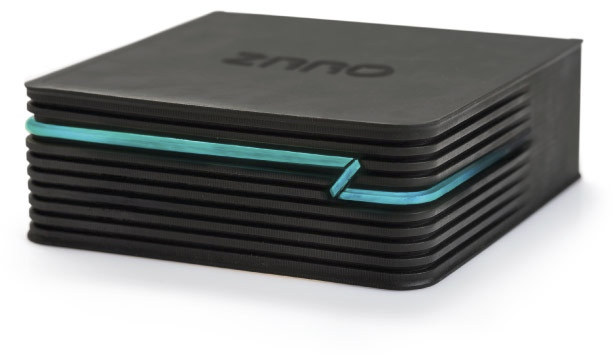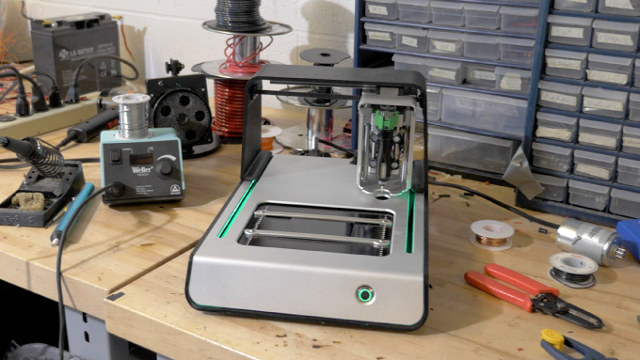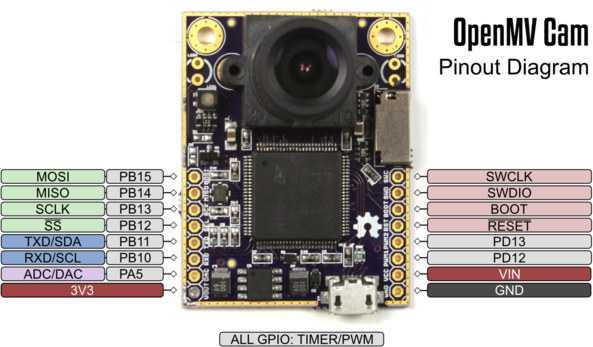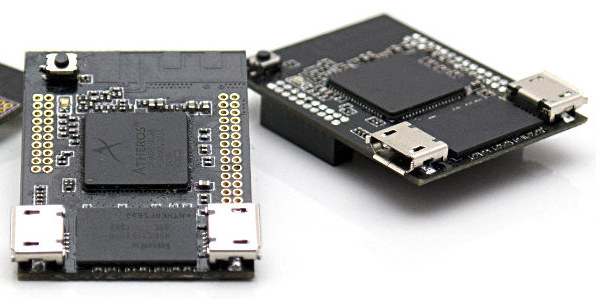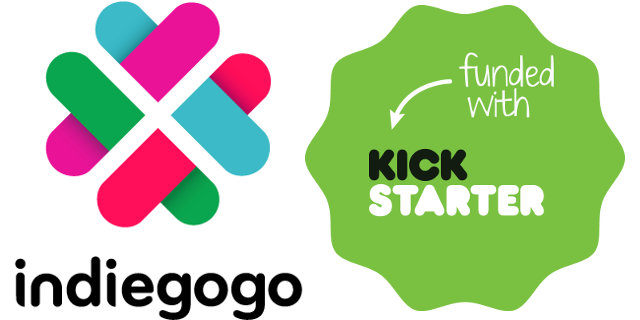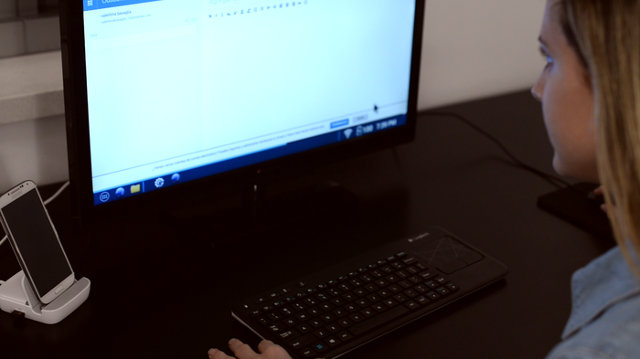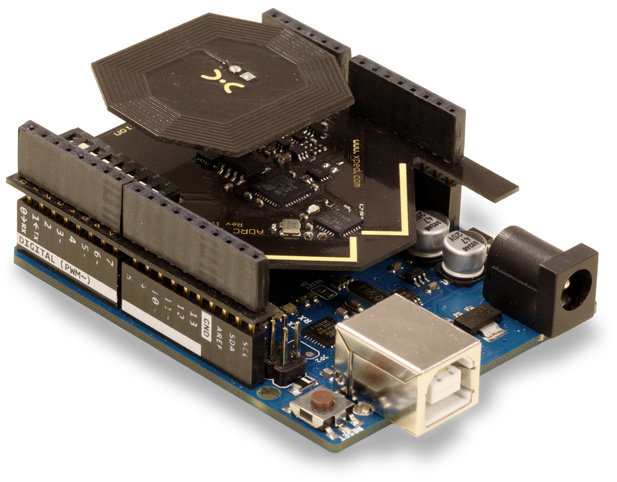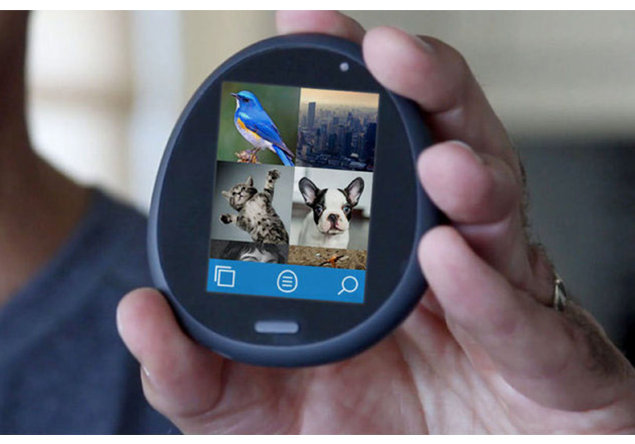Android games are fun to play… on smartphones and tablets, but if you want to play such games on a TV screen via an Android mini PC, it can become more problematic, as most of the games were designed for touchscreen, so you have to be prepare to juggle between input devices.. In my reviews, I have to play Candy Crush Saga with an air mouse, and I switch to a wireless gamepad for racing games such as Riptide GP2 or Beach Buggy Racing, while some games are simply not playable at all without touch emulation, unless you install a software remote such as Droidmote on your smartphone, and use the latter as a controller, which may not be ideal either. ZRRO, an Israeli company, came with a new package comprised of an Android game console (ZRRO Box), and a game controller (ZRRO Pad) featuring a hover and touch surface […]
Voltera V-One is a Low Cost PCB Printer and Solder Paste Dispenser (Crowdfunding)
The traditional hardware development cycle involve sending PCB Gerber files to a manufacturer, wait a few days (or weeks), get the boards back, find and fix bugs, send a new revision of the gerber files to the manufacturer and so on. This wastes a lot of time, so PCB printers capable of handline single and dual layer PCBs have started to see the light of the day, for example with BotFactory Squink. The latter can also do pick and place, but costs over $3,500. Luckily if you’d like something cheaper, Voltera V-One will do many of the same tasks, for but for only $1,500. Voltera V-One specifications: Minimum Trace Width – 8mil (~0.2mm) Minimum Passive Size – 0603 (0402 for solder paste) Minimum Pin-to-Pin Pitch – 0.8mm (0.5mm for solder paste) Resistance – >12 mOhm/sq @ 70um height Max Heated Bed Temperature – 250C Heated Bed Ramp Rate – ~2C/s […]
OpenMV is an Open Source Hardware VGA Camera Controllable with Python Scripts (Crowdfunding)
Recently I’ve seen some activity about tiny cameras for makers, including Linux based SinoVoIP BPI-D1 recording up to 720p30 videos, and an upcoming mini camera for VoCore Wi-Fi module. There’s now another project called OpenMV, and open source camera for machine vision applications based on STMicro STM32, recording up to VGA resolution at 20 fps, and controlled using Micro Python scripts. OpemMV camera specifications: MCU – STM32F427, 180MHz, 225 DMIPS, 256K SRAM, 2M Flash, DMA/FPU/DSP/DCMI/SDIO/2D Acceleration Camera – 2MP OV2640 sensor with interchangeable M12 lens, 2x IR LEDS Storage – uSD interface: SDIO (4-bit mode) Expansions – 2x headers with USART, SPI, I2C, PWM, ADC/DAC, GPIOs, PWM and power signals USB – micro USB 2.0 Full Speed port Power Supply – 5V via USB; Current draw is approximately 140mA, steady state Dimensions – 4.57 x 3.56 cm The camera can be controlled using (Micro) Python scripts. with the project’s OpenMV […]
Black Swift is a Tiny OpenWRT Wi-Fi Board Powered by Atheros AR9331 (Crowdfunding)
In case you thought there were not enough Wi-Fi board in the market already, here’s another one with Black Swift. The board runs OpenWRT, is a little larger than Vocore, and quite smaller than WRTnode, is powered by Atheros AR9331, provides access to I/Os via headers, and comes with two micro USB ports which should make it easy to use, and allow some interesting applications with USB devices. Black Swift specifications: SoC – Qualcomm Atheros AR9331 32-bit MIPS 24K CPU core @ 400 MHz, or 200 MHz in energy-saving mode selectable by software System Memory – 64 MB DDR2 SDRAM Storage – 16 MB NOR flash Connectivity – 802.11 b/g/n Wi-Fi (1×1, up to 150 Mbps) with PCB antenna USB – 1 x microUSB for power, 1x microUSB 2.0 port Expansion – Headers for 26x GPIO, 2x Fast Ethernet, SPI, I²C, 1x 16550 UART, 1x USB 2.0 Misc – Factory reset […]
Crowdfunding Report for 2014 on CNX Software Blog
Following up on my 2013 Crowdfunding Report, I’ve gone through all 55 Kickstarter and Indiegogo crowdunding projects featured on CNX Software between December 2013 and November 2014 (inclusive) to see how well they fared. The table below sort projects chronologically as they were published on this very blog. Date Project Crowdfunding Site Funded? Pledged amount / Goal Expected Delivery Actual Delivery Comments 2. Dec. 2013 Micro Python Kickstarter Yes 97,803 GBP / 15,000 GBP 03/2014 04/2014 Available @ https://micropython.org/store/#/store 5. Dec. 2013 Plugaway Kickstarter Yes $162,835 AUD / $50,000 AUD 04/2014 – People upset because of lack of updates. Project might be dead, and backers lost their money 6. Dec. 2013 AIRTAME Indiegogo Yes $1,268,332 / $160,000 05/2014 12/2014 People have started received the beta versions, after a massive 8-month delay 7. Dec. 2013 Crystal Board Kickstarter No $14,574 / $200,000 04/2014 – The project appears to be dead 10. […]
Andromium Transforms Your Smartphone into a mini Desktop PC (Crowdfunding)
Mobile desktop convergence has been a buzz word for several years now, and people have tried to use their smarphone as a desktop PC for a while thanks to technologies like MHL, which allows an easy connection between a phone and TV. However, mobile operating systems such as Android are not really suited for desktop use, and it can be a frustrating experience, so there needs to be different user interface in desktop and mobile modes for an optimal user experience. Canonical is working on this, and Ubuntu Edge, an ambitious, but ultimately failed crowdfunding campaign, was part of the strategy for convergence. But a team of developers lead by an ex-Google employee has been designed a solution with a desktop OS (Andromium OS) and a docking station that let you use your smartphone as a phone on the go, and as a desktop computer while docked, with Andromium user […]
Connect Objects Wirelessly, and Create User Interfaces Easily With Xped DeB for Arduino (Crowdfunding)
Xped, an australian startup, has designed an ecosystem comprised of an Arduino shield with NFC and 802.15.4 connectivity, a Raspberry Pi Model B+ based gateway, and DeB browser that generates a user interface in Android, iOS, or Linux based on an XML file stored in an Arduino board. This allows to connect various objects wirelessly, with reduced power consumption thanks to 802.15.4, and to create user interfaces easily with a text file located in your Arduino board. ADRC stands for Auto-Discovery Remote Control, and that’s what Xped ADRC Shield allows thanks to the following hardware specifications: MCU – RM Cortex M3 32-bit microcontroller with 256 KB of FLASH memory. NFC – NDEF Type-2 Tag with bi-directional communications capability. NFP proximity communications technology which is similar to NFC but was developed by Xped to use less than 1,000th of the power and provide faster speeds than NFC. It is mainly used […]
The Egg is a Tizen Based Portable Touchscreen Cloud Server (Crowdfunding)
If you like the convenience of cloud storage, but are wary of privacy implications, and/or are not satisfied by the file download/upload transfer rate, a new device called The Egg might be what you are looking for. It’s a tiny Wi-Fi enabled cloud storage server, powered by an Intel Atom processor and running Tizen, with up to 256 GB storage that you can carry in your pocket, with your data being fully private and always accessible, and there’s also a touchscreen display to let you watch and share your media files. Egg technical specifications: SoC – Intel Atom Processor @ 2.0 GHz System Memory – 1GB RAM Storage – 64, 128, or 256GB eMMC Connectivity – Wi-Fi a/b/g/n (client / access point), Bluetooth 4.0 USB – Micro USB 2.0 type-AB for charging and file transfer from phone, camera, computer… Display – 2.4” Multi-Touch capacitive touch TFT, 240×320 resolution, 262K colors […]


